

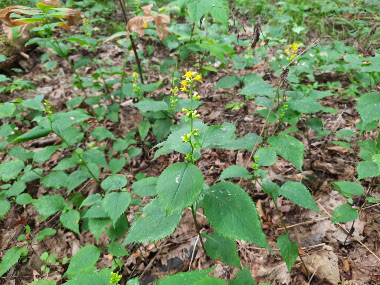
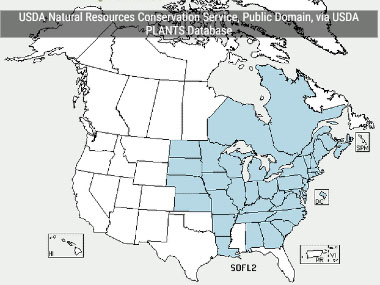
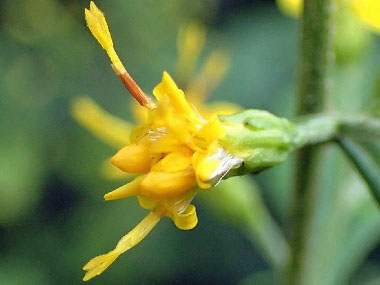
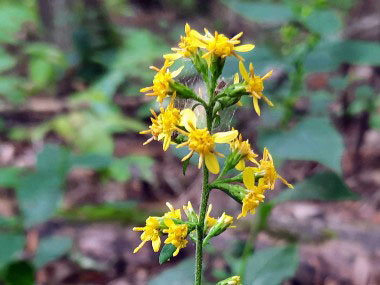
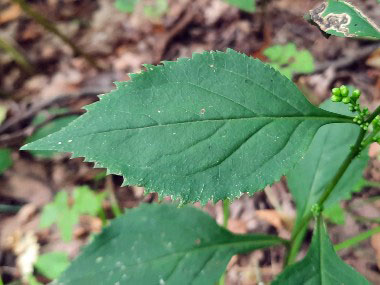
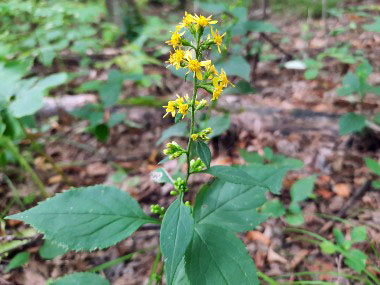
For comprehensive information (e.g. nutrition, health benefits, recipes, history, harvesting tips, etc.) please check out our Goldenrod PDF magazine.
Zigzag Goldenrod is a rhizomatous perennial that is native to eastern U.S. and Canada. This plant is in the asteraceae family. Although it is not well known as an edible plant it has a history of medicinal used. Frances Densmore, (1867 to 1957), was an ethnologist, who reported that the Chippewa used various species of Goldenrod for treating a variety of ailments. Most noteworthy was that this plant's root was chewed for toothaches.
Distinguishing Features
This is a perennial wildflower with upright unbranched stems. This goldenrod species is distinguished by its zigzag stems and its toothed, broad-ovate leaves. From late summer into autumn these plants have elongated yellow flower clusters. Smaller axillary flower racemes develop lower on the stem. Zigzag goldenrods are adaptable and quite tough. They thrive in part sun or part shade locations and in moist well-drained soils.
Flowers
Flowers appear in small, axillary clusters on the upper parts of the stems and stem ends. They bloom from mid-summer to autumn. Each flowerhead is 6mm (¼”) across with 3 to 4 ray florets and 4 to 8 disc florets. In autumn the florets mature into bullet shaped achenes.
 Fields
of Nutrition has medicinal benefits and vitamin/mineral content of Zigzag Goldenrod.
Fields
of Nutrition has medicinal benefits and vitamin/mineral content of Zigzag Goldenrod.
Leaves
Leaves are 5 to 12cm (2 to 5”) long and 2 to 10cm (1 to 4”) across with (somewhat) winged petioles. Ovate to lanceolate shaped leaves with coarsely toothed edges. Leaves are alternate, gradually becoming smaller as the stems rise.
Height
It typically grows upright to 61 to 100cm (2 to 3') tall, but in some locations it can reach 1.21 metres (4') tall. Stems are sometimes but not always in a zigzag shape.
Habitat
Zigzag goldenrods prefer rich deciduous woodlands, often on protected wooded slopes facing north or east, in low areas along woodland streams, and shaded limestone cliffs. It can be found from North Dakota south to Louisiana, throughout central and eastern U.S. and Canada.
Edible Parts
According to PFAF the leaves can be used as tea and the seeds are edible.
Other Name
Broadleaf Goldenrod.
Similar Plants
Blue-Stemmed Goldenrod.
To support our efforts please browse our store (books with health benefits, etc.).
Winter Survival Food Handbook

PDF Plant Magazines
Types of Wild Food
Geographic Zones Seasons
Disclaimer
EdibleWildFood.com is informational in nature. While we strive to be 100% accurate, it is solely up to the reader to ensure proper plant identification. Some wild plants are poisonous or can have serious adverse health effects.
We are not health professionals, medical doctors, nor are we nutritionists. It is up to the reader to verify nutritional information and health benefits with qualified professionals for all edible plants listed in this web site. Please click here for more information.
Why Edible Wild Food?
- Food costs are rising
- Free, wild food is readily abundant
- Wild food adds nutrition to your diet
- Wild food can help treat various medical conditions





